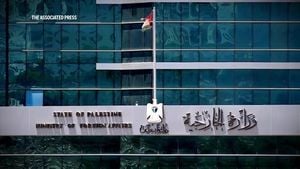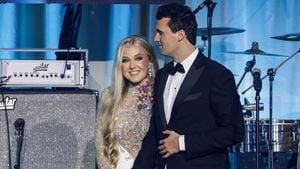Pat Gelsinger, the recently departed CEO of Intel, has left behind both legacy and turmoil at the storied technology company, leaving many to ponder the direction of the semiconductor giant as it battles fierce competition from the likes of Nvidia. Intel announced on Monday the resignation of Gelsinger, who had taken the helm of the company just under four years ago with the ambitious goal of revitalizing its fortunes. His tenure was characterized by significant strategic shifts, yet it ended amid challenges and consistently disappointing performance.
Upon his arrival at Intel, Gelsinger was seen as the savior, the long-lost son returning to his teenage roots in the company where he had begun his career. He envisioned taking the company beyond traditional endpoints like PCs and servers—a mission which involved venturing directly against competitors like Taiwan Semiconductor Manufacturing Company (TSMC) and Samsung Electronics. Gelsinger had laid out plans to expand Intel’s manufacturing capabilities, including the construction of new facilities funded under the $52 billion federal Chips and Science Act. The act aimed to bolster the U.S. semiconductor industry, which has been facing challenges from low-cost overseas production and competitors.
Despite Gelsinger's efforts—including ambitious plans to allocate $28 billion to develop new chipmaking capabilities and expansion projects, particularly at Intel's Ohio facility—he faced mounting pressure. Over the course of his leadership, Intel’s stock fell dramatically by over 61%, significantly hurting the company's market capitalization and making its valuation less than one-fourth of Nvidia's. The gulf between the two companies only widened as Nvidia capitalized on the booming demand for AI processing power, effectively taking shares of Intel's data center business. Analysts began to question whether Intel could realistically compete with Nvidia’s rapid advancement and market dominance.
The breaking point for Gelsinger came during his last board meeting, where discussions about the lack of progress on restoring Intel's competitive edge and gaining market share from rivals reached a crescendo. With rising frustrations evident, Gelsinger was faced with the choice of retiring gracefully or being forced out. According to insiders, he chose to step down, marking the end of his leadership at Intel as he concluded, "Today is, of course, bittersweet as this company has been my life for the bulk of my working career."
While Gelsinger remained confident until the end, claiming he had "a lot of energy and passion" and still boasted the board's backing, the reality was stark. Intel’s quarterly earnings report released earlier this year was dismal, when the company reported losses and announced plans to cut more than 15% of its workforce, which totaled around 110,000. All these developments translated to significant job cuts, unsettling investors and raising concerns about the brand's commitment to its overarching goals.
The leadership shift has moved to interim co-CEOs David Zinsner and Michelle Johnston Holthaus, both of whom have extensive backgrounds at Intel. They will lead the company as the board initiates the search for Gelsinger's permanent successor. This transitional leadership, coupled with chair Frank Yeary stepping up as interim executive chair, may signal new strategies and shifts, as the board openly contemplates Intel's path forward. "We know we have much more work to do at the company and are committed to restoring investor confidence," Yeary commented.
Though the market reacted favorably to Gelsinger's resignation initially, Intel's shares climbing by about 4% on the news, the company still has substantial challenges to tackle. With AI now at the forefront of many semiconductor discussions, Intel's struggle to solidify its position as both supplier and innovator remains precarious. Not only is there pressure to improve product offerings and operational efficiencies, but also to respond strategically to the extremely competitive environment energized by the rise of artificial intelligence.
Gelsinger's departure reflects broader themes of transition and perhaps radical restructuring within Intel as it prepares to navigate these turbulent waters. The need to not only regain investor confidence but also to reclaim its lost dominance places the newly formed leadership under immediate scrutiny. Reports suggest analysts see Gelsinger's exit as opening the door for new strategic initiatives, signaling shifts which could realign Intel with market stakes it once dominated.
"This move opens the door for a new strategy, which we’ve been advocating for some time," said Chris Caso, analyst with Wolfe Research. This remark indicates hope for Intel adopting more flexible manufacturing approaches and hopefully transitioning its core focus to align with current technological demands. It has become increasingly clear: the remnants of the once-dominant chipmaker need to adapt quickly or risk becoming obsolete and overshadowed by industry leaders who have seized the mantle.
The Chips and Science Act funding route remains pivotal, where Intel has already secured nearly $7.9 billion from the government. This significant federal support may glimpse at Intel's future, yet the execution of the planned developments will be the ultimate test. With immediate stakes centered on manufacturing ambitions and competitive landscapes, Intel's board faces choices laden with seriousness and opportunity alike as they search for their next guiding force.
With continued scrutiny from shareholders and fierce competition from rivals, the next chapter for Intel under new leadership will be pivotal—not just for the company's future, but for the semiconductor sector’s overall health and competitive standing against global peers.
The challenges are clear, yet the potential for reclamation still exists for Intel. Only time will reveal whether the move back to its foundational roots, coupled with astute decision-making by incoming leadership, can lead this technology behemoth back to its former throne of dominance within the ever-evolving semiconductor arena.



